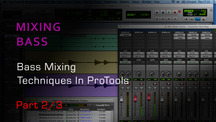This is part two our a three part series on mixing bass in ProTools. Of course, these principles can be applied to any DAW.
While I’m primarily approaching this with regards to bass guitar, these principles apply to any bass instrument. So whether you’re having problems with a Jazz bass or a cello, a kick drum or a Hammond B3, read on.
High-Pass Filter
Wait…what?! Aren’t we supposed to be improving the bass rather than removing it? Yep, but stay with me. I’ll explain.
We’re in search of good bass tone, right? “Tone” is such a vague term, I know, but the whole process of mixing the bass is about achieving the perfect tone for the song. The bass part you recorded may sound awesome by itself, but 99 times out of 100 you’ll need to alter it quite a bit to make it fit well in the mix. You need to dial in the tone.
So what does a high-pass filter have to do with tone? In my experience, the low frequencies of the bass actually tend to distract me from the tone I’m trying to create.
Everything below 100 Hz is mostly “rumble.” It’s the part of the bass that you “feel” more than you hear. Of course we want this to be present in our mix, but while dialing in the bass tone, I like to get rid of this rumble temporarily.
Here’s what I do. I use a high-pass filter to roll off everything below 100 Hz. From there, I’ll use the rest of the EQ to carve out the bass tone I’m looking for. Once I’m happy with the tone, I’ll slowly re-introduce the low-end rumble back into the track by slowly rolling the high-pass filter back to the left.
Sometimes I’ll remove the high-pass filter entirely. Other times it sounds right to leave the HPF around 50 or 60 Hz. Depending on the style of music, it might make more sense to have more or less sub-bass in your mix.
Cure the Headache
I’ve spent hour and hours EQ-ing bass guitar. Over the course of all this “quality time” with my favorite instrument, I’ve realized that my brain does not like low-mids. I literally get a headache if I don’t get rid of this low-mid boom quickly.
Do you know what I’m talking about? You hear the bass, and it doesn’t necessarily sound bad, but there’s something about the low-mids that almost seems to “press in” on your head?
I used to be annoyed by this, but I later realized that these headaches are pretty helpful for mixing! Initially, I couldn’t tell what was causing the headaches, but I finally figured out that it was the bass. Particularly somewhere between 100 and 500 Hz.
Almost every bass guitar you ever record will have a bit too much energy in this range. When you combine it with guitars, vocals, keyboards, etc., there’s just and overwhelming amount of low-mid information.
Which frequency you need to cut varies from bass to bass (and also from performance to performance). Finding the offensive frequency can be easy. Simply do an exaggerated boost with the EQ (something like 12 dB), and sweep the frequency around until you find the most annoying frequency.
Once you’ve found it, destroy it. No EQ cut is too extreme when EQ-ing bass. Here’s a screenshot of my EQ settings for a bass part I recently recorded: Looking at the EQ curve, you’d think this bass part must have sounded awful to begin with. Nope. This is just what I needed to do to get it to sit well in the mix. (There was wicked build-up of muddiness at 200 Hz, hence the 9 dB cut.)












